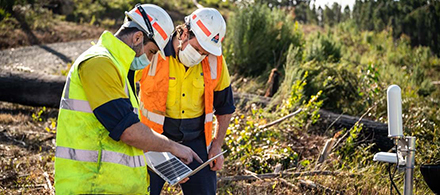VicForests has started using drones at night to detect endangered fauna to comply with new orders from the Victorian Supreme Court that have temporarily led to the closure of the native forest industry. Source: Philip Hopkins, LaTrobe Valley Express
The state’s native harvest operator is working with drone operators to trial technology that is enabling surveys of nocturnal arboreal fauna, particularly gliders and owls.
The new survey techniques detect Greater Gliders and their home ranges and any Yellow-Bellied Gliders, their feed trees; and all hollow-bearing trees to comply with the court orders.
“Using drone technology to survey removes the need for dangerous nighttime, foot-based surveying,” said VicForests in a statement.
“The safety of our staff and contractors is our highest priority.”
Drone operators have been hired to conduct the necessary surveys.
The drones operate a thermal camera to detect hotspots when flying over a forest canopy at night.
When a hot spot is identified, the drone switches to a normal light video and uses a spotlight to zoom in to enable the species to be identified.
The location of the fauna can then be recorded, along with images.
VicForests says drones allow it to conduct safe, consistent, systematic and faster monitoring than boots-on-the-ground techniques that use spotlighting.
The new surveying method also enables our ecologists to verify detections and seek to have the data included in the Victorian Biodiversity Atlas,” the government body said.
The Supreme Court’s findings and orders obliged VicForests to undertake additional surveys before future timber harvesting operations to meet the court’s new interpretation of what is required under the state’s timber regulations.
The court has also ordered new additional protections beyond the specific rules in the regulations.
VicForests’ appeal against the decision was heard in late March, and the native forest operator is waiting on the Court of Appeal’s verdict.
VicForests has rejected as false and misleading allegations that these orders meant VicForests had been harvesting illegally.
“These words do not appear anywhere in the 168-page judgment,” it said.
As a government agency, VicForests is subject to the ordinary governance obligations and control of other government agencies.
“There has been no view expressed by the court that VicForests would act in any way other than in compliance with these orders,” it said.
“Suggestions that VicForests is continuing to harvest illegally or is ‘rogue’ are unfair and untrue.”
VicForests relies on pre-harvest spotlight surveys conducted by the Department of Environment, Land, Water and Planning (DELWP) in addition to spotlight surveys carried out by its own staff and contractors.
Traditionally, DELWP and VicForests do not survey an entire coupe, but conducted single transects about one kilometre long in proposed coupes where gliders are likely to be detected.
These spotlight surveys are conducted at night, on foot, using a spotlight and a hand-held thermal camera, in areas most likely to contain gliders.
The results enabled VicForests to derive a measure of glider density.
The Supreme Court found these survey techniques as inadequate to protect the endangered greater glider and yellow-tailed glider.
These survey standards were developed by the Arthur Rylah Institute and are also used within the Department of Energy Environment and Climate Action (DEECA) Forest Protection Survey Program.
The Victorian government’s Greater Glider Action Statement No 267 says the Greater Glider is threatened and faces threats that are likely to lead to extinction.
Threats include habitat degradation and the risks associated with small, fragmented populations, including genetic decline.
The statement says factors contributing to elevated mortality and the loss of hollow-bearing trees include bushfire, planned burning, drought, timber harvesting and hyper-predation.
“Native forest timber harvesting in the eastern and central parts of Victoria overlaps with the main distribution and habitat of the Greater Glider,” the statement says.
“Timber harvesting has the potential to affect Greater Glider populations through localised habitat modification, however timber harvesting occurs in a relatively small proportion of the total area of habitat occupied by Greater Gliders.”
More information about VicForests’ research and monitoring is available via www.vicforests.com.au/vicforest-forest-management/managing-forest-values/page/overview






